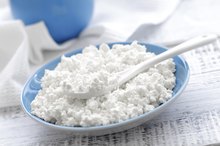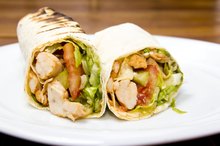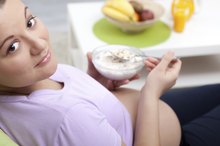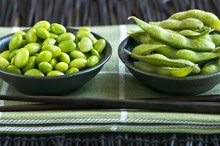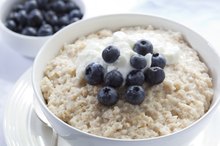What does fact checked mean?
At Healthfully, we strive to deliver objective content that is accurate and up-to-date. Our team periodically reviews articles in order to ensure content quality. The sources cited below consist of evidence from peer-reviewed journals, prominent medical organizations, academic associations, and government data.
- Harvard Health Publications: Calorie Counting Made Easy
- Harvard Heath Publications: Glycemic Index and Glycemic Load for 100+ Foods
The information contained on this site is for informational purposes only, and should not be used as a substitute for the advice of a professional health care provider. Please check with the appropriate physician regarding health questions and concerns. Although we strive to deliver accurate and up-to-date information, no guarantee to that effect is made.
The Best Diet for Diabetic Weight Loss
Although diabetics do need to be careful about how many carbs they eat, a diabetic weight-loss meal plan includes a variety of healthy, carb-containing foods. The American Diabetes Association says diabetic meal plans often contain three meals and two snacks daily 1. The best diet for diabetic weight loss consists of a regular meal plan, reduced calorie intake and a controlled carbohydrate intake.
Calorie and Carb Recommendations
The number of calories diabetics should eat daily for weight loss depends on their usual calorie intake. However, eating 1,200 calories daily for women and 1,500 calories per day for men is a good place to start. The American Diabetes Association suggests diabetic diets provide about 45 percent of the calories from carbohydrates 1.
- The number of calories diabetics should eat daily for weight loss depends on their usual calorie intake.
- The American Diabetes Association suggests diabetic diets provide about 45 percent of the calories from carbohydrates 1.
Blood Sugar Control
The Best Food for Diabetics to Eat
Learn More
Since carbs are your body’s preferred energy source, diabetics do need to keep carbs in their diet during weight loss. However, limiting carbs to about 60 grams during meals and no more than 25 grams of carbs for snacks helps diabetics control their blood sugar levels, notes the American Diabetes Association 1. Choosing foods that contain healthy carbs helps keep blood sugar in check. High-fiber carbs or foods containing carbs combined with protein -- such as:
- whole grains
- legumes
- nonstarchy vegetables
- milk
- yogurt
- fruit
- nuts
- seeds -- have lower glycemic indexes
- which is beneficial for blood sugar control
- Since carbs are your body’s preferred energy source, diabetics do need to keep carbs in their diet during weight loss.
- However, limiting carbs to about 60 grams during meals and no more than 25 grams of carbs for snacks helps diabetics control their blood sugar levels, notes the American Diabetes Association 1.
Low-Carb Options
While diabetics don’t have to follow low-carb diets to be healthy and lose weight, choosing plenty of foods rich in protein or healthy fats is another excellent way to help control blood sugar during weight loss. Examples of healthy low-carb options that are rich in protein -- a satiety booster -- include:
- seafood
- unbreaded poultry
- seafood
- egg whites
- reduced-fat cheese
- low-fat cottage cheese
- plain nonfat Greek yogurt
- nuts
- seeds
- nut butters
Though lacking in protein, plant-based oils contain heart-healthy fats and are carb-free.
Sample 1,500-Calorie Menu
Can a Diabetic Eat Cottage Cheese?
Learn More
For a midmorning snack, try 1.5 cups of fruit-flavored Greek yogurt. A healthy lunch might include 2 ounces of grilled chicken breast, 2 teaspoons of olive oil, 1 cup of asparagus and 1 cup of cooked quinoa. For an afternoon snack, try 1 cup of sliced strawberries, 1 ounce of almonds and 1 ounce of reduced-fat cheese. A nutritious dinner includes a lean turkey burger on a whole-grain bun, 2 cups of leafy greens, 1 tablespoon of Italian salad dressing and five whole-grain crackers.
- For a midmorning snack, try 1.5 cups of fruit-flavored Greek yogurt.
- For an afternoon snack, try 1 cup of sliced strawberries, 1 ounce of almonds and 1 ounce of reduced-fat cheese.
Related Articles
References
- American Diabetes Association: About Our Meal Plans
- Harvard Health Publications: Calorie Counting Made Easy
- Harvard Heath Publications: Glycemic Index and Glycemic Load for 100+ Foods
- Centers for Disease Control and Prevention. Diabetes and carbs. Updated September 19, 2019.
- Harvard T.H. Chan School of Public Health. Carbohydrates and blood sugar.
- American Diabetes Association. 5. Facilitating Behavior Change and Well-being to Improve Health Outcomes: Standards of Medical Care in Diabetes-2020. Diabetes Care. 2020;43(Suppl 1):S48-S65. doi:10.2337/dc20-S005
- EndocrineWeb. Treatment of diabetes: The diabetic diet. Updated April 2, 2019.
- American Diabetes Association. 6. Glycemic targets: Standards of medical care in diabetes-2020. Diabetes Care. 2020;43(Suppl 1):S66-S76. doi:10.2337/dc20-S006
- American Diabetes Association. Meal planning.
- Chang CR, Francois ME, Little JP. Restricting carbohydrates at breakfast is sufficient to reduce 24-hour exposure to postprandial hyperglycemia and improve glycemic variability. Am J Clin Nutr. 2019;109(5):1302-1309. doi:10.1093/ajcn/nqy261
- Harvard T.H. Chan School of Public Health. Sugary drinks.
- American Heart Association. Added sugars. Updated April 17, 2018.
- American Diabetes Association. Diabetes self-management education.
- dLife. Blood tests for diabetes: two-hour postprandial glucose test. Updated September 2017.
- American Diabetes Association. Carbohydrate counting. October 25, 2015:
- Centers for Disease Control and Prevention. Diabetes and carbohydrates. 2019.
Writer Bio
Erin Coleman is a registered and licensed dietitian. She also holds a Bachelor of Science in dietetics and has extensive experience working as a health writer and health educator. Her articles are published on various health, nutrition and fitness websites.

